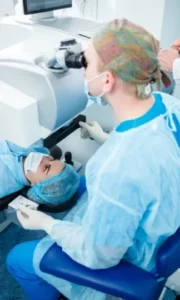Choosing between RLE Surgery and Contoura for better vision? It can be confusing! But don’t worry, we’re here to help. In this blog, we’ll talk about RLE Surgery vs Contoura, comparing them side by side, from costs and recovery times to success rates. By the end, you’ll be armed with the insights needed to make a well-informed decision about your vision’s future. So, let’s start our easy-to-follow guide!
Contents
Understanding RLE Surgery
 Refractive Lens Exchange, popularly known as RLE Surgery, is an innovative eye procedure. But what is it, really? Let’s break it down:
Refractive Lens Exchange, popularly known as RLE Surgery, is an innovative eye procedure. But what is it, really? Let’s break it down:
- What it is: RLE Surgery involves removing the eye’s natural lens and replacing it with an artificial one. This new lens can correct vision problems like nearsightedness, farsightedness, and even presbyopia (age-related vision changes).
- The Procedure: It’s a lot like cataract surgery. A small incision is made, the natural lens is gently removed, and the new artificial lens is put in its place. The best part? The incision is tiny and usually heals on its own, often without stitches!
- Benefits:
- Clearer Vision: Many patients experience clearer, sharper vision after the procedure.
- Reduced Dependence on Glasses: RLE can decrease or even eliminate the need for reading glasses or bifocals.
- Long-lasting: Unlike some procedures that may require touch-ups, the results from RLE are often permanent.
- Who’s it for? While RLE can benefit many, it’s especially useful for people who aren’t candidates for other refractive surgeries like LASIK. People with presbyopia or those with extreme refractive errors often find RLE to be a great solution.
In simple words, RLE is like giving your eyes a new, improved lens to help you see the world clearer!
Unraveling Contoura Vision
Ever heard of Contoura Vision and wondered what it’s all about? Let’s dive in:
- What is Contoura Vision? Contoura Vision is a modern, laser-assisted eye procedure designed to give you clearer, more natural vision. It’s a step up from the regular LASIK, using advanced technology to map out the unique contours of your eye.
- The Procedure: Unlike traditional methods that treat general vision issues, Contoura Vision focuses on the eye’s specific irregularities. Using topography-guided laser technology, it creates a detailed map of your eye, ensuring a highly personalized treatment.
- Benefits:
- Precision: The detailed mapping allows for a more precise correction of your vision.
- Better Quality Vision: Many patients report seeing clearer and sharper than ever before, even better than with glasses or contacts!
- Safety Boost: The procedure is designed to be minimally invasive, reducing the chances of complications.
- What Does It Address? Contoura Vision is great for treating myopia (nearsightedness), astigmatism, and even some cases of hyperopia (farsightedness). If you’ve been told you’re not a candidate for regular LASIK, Contoura might be the answer!
In a nutshell, Contoura Vision offers a tailor-made solution, adjusting to the unique needs of your eyes and aiming for the best possible results.
Cost Comparisons: RLE Surgery vs Contoura
Deciding between RLE and Contoura can be challenging, especially when considering the costs involved. Let’s break down the expenses for both to help you make an informed decision.
- Initial Procedure Costs:
- Contoura: Generally starts from about 25,000 per eye. This cost largely revolves around the laser technology and expertise of the surgeon.
- RLE: Starts around 35,000 per eye, influenced by the quality of the artificial lens chosen and the surgical expertise.
- Post-Operative Care:
- Contoura: After the procedure, follow-up visits and any prescribed eye drops are additional costs. These expenses can vary but typically are less since it’s a non-invasive procedure.
- RLE: Post-operative care for RLE may be slightly higher than Contoura. This includes periodic check-ups, medications, and potential treatments to ensure the artificial lens is settling correctly.
- Geographical Variations:
- Costs can differ based on the location of the clinic or hospital. Metropolitan areas with high-end clinics may charge more due to the expertise and state-of-the-art facilities they offer.
- Technology Used:
- Contoura: The technology is pretty standardized, but costs can vary based on the precision of the equipment and any additional features it may have.
- RLE: Different types of artificial lenses, from basic to premium, can significantly impact the cost.
- Additional Factors:
- Both surgeries might have unexpected costs. It’s crucial to consider potential expenses like travel, accommodations (if the clinic is far), or any unplanned post-surgery treatments.
While RLE has a higher starting price, the total cost will depend on many factors, including the chosen lens and post-surgery care. Contoura, though initially cheaper, also comes with its set of additional expenses. Before making a decision, consult with your ophthalmologist, discuss all potential costs, and ensure you’re making the best choice for your eyes and budget.
Success Rates and Outcomes
 When it comes to deciding between RLE and Contoura, understanding their success rates and outcomes can provide crucial insight.
When it comes to deciding between RLE and Contoura, understanding their success rates and outcomes can provide crucial insight.
RLE has been practiced for decades and, over the years, has witnessed significant advancements. Studies have shown that RLE boasts a high success rate, especially with the introduction of modern intraocular lenses (IOLs) that cater to a range of vision needs.
Many patients who undergo RLE not only eliminate their cataracts but also significantly reduce or completely get rid of their dependence on glasses. Patient satisfaction post-RLE is often high, with individuals reporting enhanced quality of life due to clearer vision across distances.
Contoura is a more recent entrant in the world of vision correction but has quickly gained popularity due to its precision and effectiveness. Studies on Contoura indicate a very high success rate, with a significant percentage of patients achieving 20/20 vision or better post-surgery.
However, it’s worth noting that Contoura primarily focuses on the cornea, meaning certain age-related vision issues like presbyopia might still necessitate reading glasses. When it comes to patient satisfaction, the feedback is overwhelmingly positive, with many reporting life-changing results and a drastic reduction in or elimination of their dependence on spectacles.
In summary, both RLE and Contoura have carved their niches in the domain of vision correction. Their high success rates and favorable outcomes speak volumes about their efficacy. The best choice, ultimately, depends on individual vision needs, age, and the specific conditions being addressed.
Potential Risks and Complications
| Aspect | Refractive Lens Exchange (RLE) | Contoura Vision |
|---|---|---|
| Infection Risk | While rare, there’s a possibility of infection after the surgery, which can be managed with antibiotics. | Infections are infrequent with Contoura, and when they do occur, they’re typically mild. |
| Visual Disturbances | Some patients might experience glare, halos, or starbursts, especially at night. | Post-surgery, a few patients may report halos or glares, but these usually diminish over time. |
| Residual Refractive Error | There’s a slight chance the chosen IOL might not fully correct the vision, necessitating glasses. | Some patients might still need glasses for certain tasks if complete correction isn’t achieved. |
| Surgical Complications | Risks include lens dislocation, retinal detachment, or increased eye pressure, though they’re rare. | Being a laser procedure, surgical complications are minimal but can include flap complications. |
| Dry Eyes | Temporary dryness can occur post-surgery, which can be managed with lubricating eye drops. | Dry eyes are a common side effect but usually resolve within weeks to months. |
| Corneal Issues | The cornea is usually not affected in RLE. | Ectasia, a thinning of the cornea, is rare but can be a complication of any laser eye surgery. |
It’s essential to understand that while these risks are documented, they’re generally rare, and both procedures have high safety profiles. Always discuss potential risks with your surgeon to get a clear understanding tailored to your specific circumstances.
Making the Choice: Factors to Consider
Choosing between Refractive Lens Exchange (RLE) and Contoura Vision is a significant decision, one that can shape the clarity of your sight for years to come. Here are some pivotal factors to weigh in while making your choice:
- Age: Typically, older patients, especially those above 45, might find RLE more beneficial. On the other hand, younger patients might gravitate towards Contoura, given its non-invasive nature and swift recovery.
- Current Vision Status: If you have a high refractive error (above 8 diopters), Contoura might not be the optimal solution, and RLE could be better suited. Additionally, for those with cataract development, RLE serves the dual purpose of correcting refractive errors and removing the cataract.
- Recovery Expectations: Contoura has a quicker recovery time, usually spanning a few days to a week. In contrast, RLE might require a slightly more extended recovery, but the outcomes can be more comprehensive.
- Long-term Implications: Consider the longevity of the solution. RLE, for instance, offers a permanent lens replacement, minimizing the chances of future vision issues related to the lens. Contoura reshapes your cornea, and while it provides lasting results, certain life factors, like age-related changes, might affect vision down the line.
In the end, the best approach is to have an in-depth consultation with an ophthalmologist who can assess your unique eye health and vision needs, guiding you towards the most fitting solution.
Conclusion
The journey to clearer vision is a transformative experience, promising not just enhanced sight but a better quality of life. Whether you lean towards RLE or Contoura, the most critical step is to stay informed and prioritize your visual needs. With the insights shared in this guide, you’re now better equipped to navigate your vision correction journey. Remember, clarity isn’t just about seeing better; it’s about living better.
Take the first step today. If you’re keen on exploring these vision correction solutions further, let the experts guide you. Book your free appointment now at Best Eye Hospital in India or call us on 9711116605.



